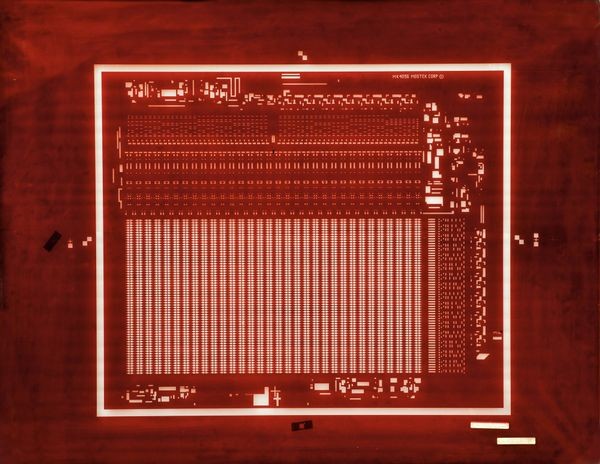MOS DRAMs Replace Magnetic Core Arrays
Mostek 4096-bit (4K) DRAM, 1973
Advanced process and design techniques allowed start-up Mostek to squeeze the MK4096 (mask shown here) into a compact 16-pin package that became the industry standard.
MOS DRAMs Replace Magnetic Core Arrays
By the early 1970s, dynamic circuit designs, coupled with the silicon gate MOS (Metal-Oxide-Silicon) process, made DRAM chips competitive in cost with magnetic cores.
Introduced at 1¢ per bit, Intel’s 1024-bit 1103 DRAM opened the market for semiconductor main memory. In 1972, IBM pioneered a fast N-channel MOS process for its System 370 Model 158 and quickly became the world’s largest semiconductor memory manufacturer.
For the next 30 years, advances in technology—coupled with aggressive international competition—increased density by a factor of four approximately every three years. A 4K-bit device arrived in 1973, the 16K in 1976 and the 64K in 1979. The first gigabit (1,000 million bits) DRAM arrived in 2000. Every increase in density brought a corresponding decrease in cost that opened up new applications in PCs, games, and portable electronic products.
Intel 1103 1024-bit (1K) DRAM
The Intel 1103 was difficult to build and use, yet a price of 1¢ per bit and a speed compatible with logic circuits made it the first widely used semiconductor main memory device.
View Artifact DetailHitachi 256K DRAM, 1985
Encouraged by the Japanese government, Hitachi, NEC, Fujitsu, Mitsubishi and Toshiba formed a research consortium that led to DRAM market dominance at the 64K density level and above.
View Artifact Detail200 mm (8-inch) silicon wafer for flash memory
Wafer vendors started using metric measurements in the early 2000s.
View Artifact Detail2-inch silicon wafer for 4K DRAMs
2-inch wafers were the standard in the early 1970s.
View Artifact DetailMostek 16K DRAM
Mostek continued its leadership in commercial DRAM design by adopting IBM’s patented one transistor/bit memory cell for the 16K generation. It could store about two pages of text.
View Artifact DetailMicron 1G DRAM
This chip can hold 1 billion bits (1Gb, 125MB) of information, or enough to store about 25 songs. A special synchronous “DDR3” architecture allows very high speed data transfer.
View Artifact Detail300 mm (12-inch) silicon wafer for DRAMs
It’s hard to predict how big wafers will be in the future.
View Artifact Detail






